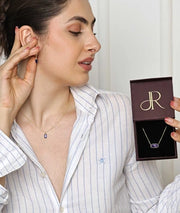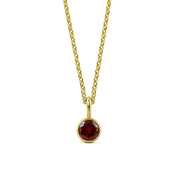Gold jewelry is prized not just for its beauty, but also for its lasting value and sentimental significance. However, with countless gold-plated and imitation pieces available today, it can be tricky to know if a necklace is truly gold. Whether it is a cherished family heirloom or a recent purchase, understanding the authenticity of your jewelry is essential.
In this blog, we will guide you through ways to determine if your necklace is real gold. From simple at-home tests to expert techniques and professional tips, you will gain the knowledge needed to make confident jewelry decisions.
Why It’s Important to Identify Real Gold
Gold jewelry is not only a fashion statement but also an investment. Real gold retains value over time and doesn’t tarnish or corrode. Fake or gold-plated pieces may look beautiful at first but tend to fade, chip, or turn your skin green.
Knowing the truth about your necklace helps you:
-
Avoid overpaying
-
Prevent allergic reactions
-
Ensure it lasts longer
-
Understand its resale or insurance value
Learn More: Can Water Ruin Gold-Plated Jewelry?
How to Know If Your Necklace Is Real Gold
if your necklace is made of real gold or just gold-colored metal? Don’t worry there are a few simple tests you can try at home to figure it out before heading to a jeweler.
1. Check for a Hallmark or Stamp
Real gold jewelry typically has a small stamp engraved in a discreet area (like the clasp or pendant bail). This stamp indicates the gold’s purity in karats (K) or parts per thousand (e.g., 14K or 585).
Common Gold Markings:
-
24K or 999 = Pure gold
-
22K or 916 = 91.6% pure
-
18K or 750 = 75% pure
-
14K or 585 = 58.5% pure
-
10K or 417 = 41.7% pure
If your necklace lacks a stamp, it might not be real or it could be worn off.
2. Use the Magnet Test
Real gold is not magnetic. Try placing a small magnet near your necklace:
-
If it sticks: It likely contains other metals (not real gold).
-
If it doesn’t react: It could be real, or at least gold-plated.
Note: This isn’t foolproof, but it’s a quick and easy first step.
3. Do a Visual and Skin Check
Color Consistency
Examine the necklace closely. Real gold has a warm, uniform color. If you see discoloration, flaking, or spots where the “gold” is wearing off chances are it’s plated.
Skin Reaction
Gold doesn’t react with skin. If your necklace turns your neck green or black, it’s likely fake or mixed with base metals like copper or nickel.
4. Try the Float Test
Drop your necklace in a cup of water:
-
Real gold sinks immediately.
-
Fake gold may float or take time to settle due to lightweight metals inside.
Make sure to dry your jewelry properly after this test to prevent damage to any non-gold components.
5. Rub Test with a Ceramic Plate
Find an unglazed ceramic tile or plate:
-
Rub your necklace gently on the surface.
-
Real gold leaves a gold streak.
-
Fake gold leaves a black or greenish streak.
Use caution with this method it may cause surface scratches.
6. Acid Testing (for Advanced Users)
This test involves applying a small drop of nitric acid to your jewelry. If there’s no reaction, it’s real gold. If it turns green or bubbles, it’s likely fake.
Important:
-
Always wear gloves and work in a ventilated area.
-
This is best done by professionals or jewelers.
7. Consult a Jeweler
When in doubt, visit a trusted jeweler. They can test your necklace using:
-
Electronic gold testers
-
X-ray fluorescence (XRF) machines
-
Density and weight checks
Professional evaluations are often quick, affordable, and 100% reliable.
Common Misconceptions About Real Gold
Many people assume they can spot real gold just by looking or feeling it, but that’s not always the case. Here are a few myths that often lead to confusion.
If it’s heavy, it must be real.
Not always true. Some fake jewelry uses heavy metals to mimic gold’s density.
Gold never scratches.
Real gold is soft especially 24K. Scratches are common in genuine pieces.
Tarnish means it’s fake.
Not always. While gold doesn’t tarnish, other elements (like solder or mixed alloys) might.
Explore More: Shine That Stays: The Truth About Gold-Filled Jewelry
Final Thoughts
Knowing if your necklace is real gold brings confidence, clarity, and peace of mind. While simple at-home tests can give you hints, professional verification is the most reliable way to ensure authenticity.
Gold jewelry is cherished for its elegance, warmth, and lasting value. Make sure the pieces you wear are genuine. When shopping, choose trusted jewelers like Rarete Jewelry, where every necklace reflects true craftsmanship and quality you can rely on.






